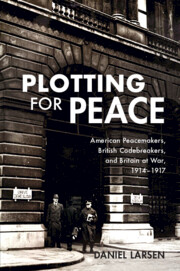Book contents
- Plotting for Peace
- Plotting for Peace
- Copyright page
- Dedication
- Contents
- Figures
- Map
- Graph and Table
- Dramatis Personae
- Preface
- Acknowledgements
- Maps
- Introduction
- 1 The First Year of War
- 2 Strategy
- 3 Negotiations
- 4 Deliberations
- 5 The Gamble
- 6 The Knock-Out Blow
- 7 The Fall of Asquith
- 8 Peace Moves
- 9 The Zimmermann Telegram and Wilson’s Move to War
- Conclusion
- Book part
- Notes
- Bibliography
- Index
8 - Peace Moves
December 1916–January 1917
Published online by Cambridge University Press: 26 March 2021
- Plotting for Peace
- Plotting for Peace
- Copyright page
- Dedication
- Contents
- Figures
- Map
- Graph and Table
- Dramatis Personae
- Preface
- Acknowledgements
- Maps
- Introduction
- 1 The First Year of War
- 2 Strategy
- 3 Negotiations
- 4 Deliberations
- 5 The Gamble
- 6 The Knock-Out Blow
- 7 The Fall of Asquith
- 8 Peace Moves
- 9 The Zimmermann Telegram and Wilson’s Move to War
- Conclusion
- Book part
- Notes
- Bibliography
- Index
Summary
With the Asquithian Liberals ejected from office, Lloyd George's new government remained in denial over the severity of Britain's economic problem in the United States. Bonar Law's new responsibilities as Chancellor alerted him to the seriousness of the crisis, but he took no meaningful action. German and American moves for peace came soon after Lloyd George's ascent to power, but the new government simply sought to manoeuvre around them. British intelligence continued to serve Lloyd George poorly, sending him decrypts that again misled Lloyd George into believing that Germany and the United States were secretly collaborating. British intelligence also decrypted the infamous Zimmermann Telegram, but decided not to share it with the government. Arthur Balfour, the new Foreign Secretary, remained extremely anxious about Britain's economic position. He used a British intelligence officer in the United States, William Wiseman, to quietly keep alive the prospect of American mediation with House. House sought new negotiations between Germany and Britain via Wiseman and the German Ambassador. Germany announced a declaration of unrestricted submarine warfare, ending House's negotiations.
Keywords
- Type
- Chapter
- Information
- Plotting for PeaceAmerican Peacemakers, British Codebreakers, and Britain at War, 1914–1917, pp. 246 - 279Publisher: Cambridge University PressPrint publication year: 2021



